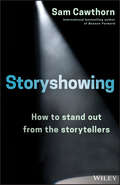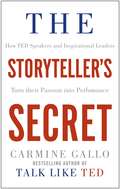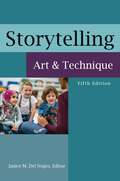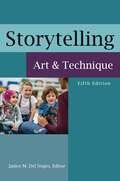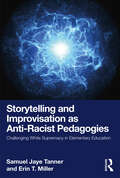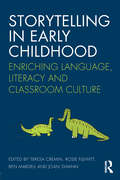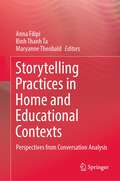- Table View
- List View
Storyshowing: How to Stand Out from the Storytellers
by Sam CawthornTake your audience on a journey to leave a more lasting impact Storyshowing is an instruction manual for making connections. Storytelling has been shown to be one of the most effective methods of persuasion, motivation and inspiration, yet the disconnect remains — you're still only telling. To truly influence people, you need to go deeper than that — you need to show them your story. By inviting your audience in, you connect on a much deeper, more emotional level; you bypass the brain and connect at the root of what it means to be human, leaving a profound impact on their entire outlook. This book shows you how to transcend telling and start showing your story, using an easy-to-follow framework you can start applying today. Unearth your own experiences, and bring your vulnerabilities out into the light; share your emotions and forge a path to true communication. Use images, body language and gestures as tools to build that indelible connection; then and only then will people truly engage and transform their thinking. No matter your message, the impact lies in the delivery. This insightful guide equips you with the tools and skills you need to start communicating like never before. Share more powerful stories using a simple 5-step method Build confidence, influence others and make a deeper connection Be more persuasive in presentations, pitches, calls and talks Transform the way people think by inviting them inside your story The difference between telling and showing is like the difference between a lecture and a play. It's the difference between giving information and taking the audience on a journey. The difference between a brochure and a test drive. Storyshowing helps you level up your communication to leave a lasting, more profound impact.
The Storyteller's Secret: How TED Speakers and Inspirational Leaders Turn Their Passion into Performance
by Carmine GalloHow did an American immigrant without a college education go from Venice Beach T-shirt vendor to television's most successful producer? How did a timid pastor's son surmount a paralysing fear of public speaking to sell out Yankee Stadium, twice? How did the city of Tokyo create a PowerPoint stunning enough to win them the chance to host the Olympics?They told brilliant stories.Whether your goal is to sell, educate, fundraise or entertain, your story is your most valuable asset: 'a strategic tool with irresistible power', according to the New York Times. Stories inspire; they persuade; they galvanize movements and actuate global change. A well-told story hits you like a punch to the gut; it triggers the light-bulb moment, the 'aha' that illuminates the path to innovation. Radical transformation can occur in an instant, with a single sentence; The Storyteller's Secret teaches you how to craft your most powerful delivery ever.In his hugely attended Talk Like TED events, bestselling author and communications guru Carmine Gallo found, again and again, that audiences wanted to discover the keys to telling a powerful story. The Storyteller's Secret unlocks the answer in fifty lessons from visionary leaders - each of whom cites storytelling as a crucial ingredient in success. A good story can spark action and passion; it can revolutionize the way people think and spur them to chase their dreams. Isn't it time you shared yours?
Storytelling: Art and Technique
by Janice M. Del NegroThis book serves as both a textbook and reference for faculty and students in LIS courses on storytelling and a professional guide for practicing librarians, particularly youth services librarians in public and school libraries.Storytelling: Art and Technique serves professors, students, and practitioners alike as a textbook, reference, and professional guide. It provides practical instruction and concrete examples of how to use the power of story to build literacy and presentation skills, as well as to create community in those same educational spaces.This text illustrates the value of storytelling, covers the history of storytelling in libraries, and offers valuable guidance for bringing stories to contemporary listeners, with detailed instructions on the selection, preparation, and presentation of stories. It also provides guidance around the planning and administration of a storytelling program. Topics include digital storytelling, open mics and slams, and the neuroscience of storytelling. An extensive and helpful section of resources for the storyteller is included in an expanded Part V of this edition.
Storytelling: Art and Technique
by Janice M. Del NegroThis book serves as both a textbook and reference for faculty and students in LIS courses on storytelling and a professional guide for practicing librarians, particularly youth services librarians in public and school libraries.Storytelling: Art and Technique serves professors, students, and practitioners alike as a textbook, reference, and professional guide. It provides practical instruction and concrete examples of how to use the power of story to build literacy and presentation skills, as well as to create community in those same educational spaces.This text illustrates the value of storytelling, covers the history of storytelling in libraries, and offers valuable guidance for bringing stories to contemporary listeners, with detailed instructions on the selection, preparation, and presentation of stories. It also provides guidance around the planning and administration of a storytelling program. Topics include digital storytelling, open mics and slams, and the neuroscience of storytelling. An extensive and helpful section of resources for the storyteller is included in an expanded Part V of this edition.
Storytelling across the Primary Curriculum
by Alastair K DanielStarting from the question ‘what is a story?’ Storytelling Across the Primary Curriculum leads the reader through the theory and practise of storytelling as an educational method – a method taught by the author over the last ten years through Primary English teaching programmes. This practical book gives teachers the skills and confidence to use storytelling and the spoken word in new and exciting ways in the classroom. It will also give teachers the confidence to ‘put down the book’ and trust themselves to tell, rather than read, a story. It provides a wealth of examples of cross-curricular teaching opportunities, including a section on the ways in which the teaching of phonics can be embedded in the 'real' language of story. Storytelling Across the Primary Curriculum is ideal for trainee and practicing primary school teachers who want to develop their classroom practice within the field of storytelling. Students on BA Primary, BEd, and PGCE courses, particularly those specialising in English, will also benefit from this book’s stimulating and intuitive approach to teaching English language and literacy.
Storytelling across the Primary Curriculum
by Alastair K DanielStarting from the question ‘what is a story?’ Storytelling Across the Primary Curriculum leads the reader through the theory and practise of storytelling as an educational method – a method taught by the author over the last ten years through Primary English teaching programmes. This practical book gives teachers the skills and confidence to use storytelling and the spoken word in new and exciting ways in the classroom. It will also give teachers the confidence to ‘put down the book’ and trust themselves to tell, rather than read, a story. It provides a wealth of examples of cross-curricular teaching opportunities, including a section on the ways in which the teaching of phonics can be embedded in the 'real' language of story. Storytelling Across the Primary Curriculum is ideal for trainee and practicing primary school teachers who want to develop their classroom practice within the field of storytelling. Students on BA Primary, BEd, and PGCE courses, particularly those specialising in English, will also benefit from this book’s stimulating and intuitive approach to teaching English language and literacy.
Storytelling and Imagination: Beyond Basic Literacy 8-14
by Rob ParkinsonStorytelling helps pupils develop a wide range of skills. Do they dream and fantasize? Do they lie, waffle and distract? These are not just bad habits but marvellous starting points for teaching an art that can help them to pass on experience, train and use imagination, develop language skills, promote their own confidence, communication and creativity and much more. Storytelling and story making may indeed be essential catalysts in developing critical and analytical thinking skills too. Storytelling and Imagination: Beyond Basic Literacy 8-14 is the complete guide to using creative storytelling in the primary school classroom and for transitions to Key Stage 3 at secondary school. Taking a holistic approach incorporating reading, writing, speaking and listening, this book covers the skills of developing stories from conceiving a tale through to performance and the oral tradition. Tried and tested by the author and by teachers in hundreds of workshops, this book provides: ideas for sparking children’s imaginations and harnessing creativity information on using storytelling in cross-curricular contexts with examples and ideas games and practical activities in each chapter a range of original and traditional stories for use in the classroom different stages of work to suit all abilities joined up thinking about stories and storytelling. More than a box of good tricks, this book is an indispensable guide for all literacy co-ordinators, practising and student teachers who are looking to create an inspiring and cross curricular approach to literacy.
Storytelling and Imagination: Beyond Basic Literacy 8-14
by Rob ParkinsonStorytelling helps pupils develop a wide range of skills. Do they dream and fantasize? Do they lie, waffle and distract? These are not just bad habits but marvellous starting points for teaching an art that can help them to pass on experience, train and use imagination, develop language skills, promote their own confidence, communication and creativity and much more. Storytelling and story making may indeed be essential catalysts in developing critical and analytical thinking skills too. Storytelling and Imagination: Beyond Basic Literacy 8-14 is the complete guide to using creative storytelling in the primary school classroom and for transitions to Key Stage 3 at secondary school. Taking a holistic approach incorporating reading, writing, speaking and listening, this book covers the skills of developing stories from conceiving a tale through to performance and the oral tradition. Tried and tested by the author and by teachers in hundreds of workshops, this book provides: ideas for sparking children’s imaginations and harnessing creativity information on using storytelling in cross-curricular contexts with examples and ideas games and practical activities in each chapter a range of original and traditional stories for use in the classroom different stages of work to suit all abilities joined up thinking about stories and storytelling. More than a box of good tricks, this book is an indispensable guide for all literacy co-ordinators, practising and student teachers who are looking to create an inspiring and cross curricular approach to literacy.
Storytelling and Improvisation as Anti-Racist Pedagogies: Challenging White Supremacy in Elementary Education
by Samuel Jaye Tanner Erin T. MillerThis book theorizes and describes the concept of transformative critical whiteness pedagogies that are rooted in theories and practices of improvisation. It shows how these pedagogies invite people, especially white people, into the urgent work of resisting the ongoing production and affirmation of white supremacy.Using the frameworks of storytelling and story analysis, this book uses narrative to invite the reader into ongoing work to design and make sense of teaching and learning about whiteness that would meaningfully account for a grapple with white supremacy. Chapter 1 offers the conceptual framework rooted in theories and practices of improvisation that allow for new ways to think about engaging whiteness in anti-racist pedagogies, which the authors name transformative critical whiteness pedagogies. Chapters 2–4 tell and analyze the stories that emerged out of this work to design and facilitate transformative critical whiteness pedagogies with white elementary students, white college students, and then black elementary students in the US. Chapters 5 and 6 discuss the challenges of developing and implementing transformative critical whiteness pedagogies in K-12 contexts. The final chapters offer a discussion of the improvisational ethos, as well as an overview of the authors’ ongoing work to engage people, especially white people, in getting smarter about whiteness.Using simple, straightforward language to address complex ideas about anti-racist pedagogies, this volume will be important reading for pre-service teachers and teacher educators in Critical Whiteness Studies, Critical Multicultural Education, Social Foundations of Education, Elementary Education, and Race and Culture Studies.
Storytelling and Improvisation as Anti-Racist Pedagogies: Challenging White Supremacy in Elementary Education
by Samuel Jaye Tanner Erin T. MillerThis book theorizes and describes the concept of transformative critical whiteness pedagogies that are rooted in theories and practices of improvisation. It shows how these pedagogies invite people, especially white people, into the urgent work of resisting the ongoing production and affirmation of white supremacy.Using the frameworks of storytelling and story analysis, this book uses narrative to invite the reader into ongoing work to design and make sense of teaching and learning about whiteness that would meaningfully account for a grapple with white supremacy. Chapter 1 offers the conceptual framework rooted in theories and practices of improvisation that allow for new ways to think about engaging whiteness in anti-racist pedagogies, which the authors name transformative critical whiteness pedagogies. Chapters 2–4 tell and analyze the stories that emerged out of this work to design and facilitate transformative critical whiteness pedagogies with white elementary students, white college students, and then black elementary students in the US. Chapters 5 and 6 discuss the challenges of developing and implementing transformative critical whiteness pedagogies in K-12 contexts. The final chapters offer a discussion of the improvisational ethos, as well as an overview of the authors’ ongoing work to engage people, especially white people, in getting smarter about whiteness.Using simple, straightforward language to address complex ideas about anti-racist pedagogies, this volume will be important reading for pre-service teachers and teacher educators in Critical Whiteness Studies, Critical Multicultural Education, Social Foundations of Education, Elementary Education, and Race and Culture Studies.
Storytelling and Story-Reading in Early Years: How to Tell and Read Stories to Young Children
by Mary MedlicottWhen a practitioner can tell and read stories well, it is proven to significantly improve young children's early communication and literacy. In this easy-to-read and essential guide, storytelling trainer Mary Medlicott gives professionals the tools to get the best out of oral storytelling and story-reading sessions, with management, performance and language techniques. Included are examples of stories and post-story activities that are most successful with children of ages 2 to 5. Medlicott shows how to prepare for the session, spark children's imagination with props, voices and facial expressions, and encourage empathy with thoughtful use of language and variety. Importantly, she gives practical advice on how to cater for all learning needs, such as children with hearing impairment or learning difficulties, and children who are learning English as a second language.
Storytelling and Story-Reading in Early Years: How to Tell and Read Stories to Young Children
by Mary MedlicottWhen a practitioner can tell and read stories well, it is proven to significantly improve young children's early communication and literacy. In this easy-to-read and essential guide, storytelling trainer Mary Medlicott gives professionals the tools to get the best out of oral storytelling and story-reading sessions, with management, performance and language techniques. Included are examples of stories and post-story activities that are most successful with children of ages 2 to 5. Medlicott shows how to prepare for the session, spark children's imagination with props, voices and facial expressions, and encourage empathy with thoughtful use of language and variety. Importantly, she gives practical advice on how to cater for all learning needs, such as children with hearing impairment or learning difficulties, and children who are learning English as a second language.
Storytelling Encounters as Medical Education: Crafting Relational Identity (Routledge Advances in the Medical Humanities)
by Sally G. WarmingtonThis innovative volume provides fresh perspectives on how medical students and patients construct identities in relation to each other, using stories of their clinical encounters. It explores how paying attention to medical students’ and patients’ stories in clinical teaching encounters can encourage empathy and the formation of professional identities that embody desirable values such as integrity and respect. Written by an experienced clinician and based on original, rigorous research combining ethnography and dialogic narrative analysis, Storytelling Encounters as Medical Education: Crafting Relational Identity includes patient stories alongside those of students and clinical teachers. This is an important contribution for all those interested in medical education, narrative medicine, person-centred care and identity formation in healthcare. It will also be of value to scholars in a range of other disciplines, who are using a dialogic approach.
Storytelling Encounters as Medical Education: Crafting Relational Identity (Routledge Advances in the Medical Humanities)
by Sally G. WarmingtonThis innovative volume provides fresh perspectives on how medical students and patients construct identities in relation to each other, using stories of their clinical encounters. It explores how paying attention to medical students’ and patients’ stories in clinical teaching encounters can encourage empathy and the formation of professional identities that embody desirable values such as integrity and respect. Written by an experienced clinician and based on original, rigorous research combining ethnography and dialogic narrative analysis, Storytelling Encounters as Medical Education: Crafting Relational Identity includes patient stories alongside those of students and clinical teachers. This is an important contribution for all those interested in medical education, narrative medicine, person-centred care and identity formation in healthcare. It will also be of value to scholars in a range of other disciplines, who are using a dialogic approach.
Storytelling Flashcards 3+ (Collins Easy Learning Preschool)
by Collins Easy LearningLevel: EYFS. Subject: English. Introduce young learners to storytelling with colourful picture cards. These educational flashcards are a fun and easy way to help children develop English skills of talking, describing and telling stories, and build their confidence with reading at home.
Storytelling for Better Behaviour: Using Traditional Tales to Explore Responsibility, Decision Making and Conflict Resolution
by Debi RobertsUsing Traditional Tales to Explore Responsibility, Decision Making and Conflict Resolution provides a method to teach students to reflect, consider and think in ways that can enhance the potential they have for making good decisions and resolving conflicts peacefully. The book provides a series of thinking tools, incorporating both graphic organisers and concept maps and are part of a thinking process known as Theory of Constraint. As well as an approach to conflict resolution, the student programme incorporating over 35 sessions, helps develop emotional literacy. The programme will help students: increase ability to empathise; improve language and communication skills; develop an understanding of conflict in terms of win-win rather than win-lose; and realise behaviour is a choice and that actions have consequences. There are comprehensive facilitator notes for all of the sessions with student PowerPoint slides to reinforce the teaching points. The CD ROM has all the student activity sheets, student PowerPoint as well as a staff development PowerPoint and a Glossary of Terms. Suitable for ages: 7 - 18.
Storytelling for Better Behaviour: Using Traditional Tales to Explore Responsibility, Decision Making and Conflict Resolution
by Debi RobertsUsing Traditional Tales to Explore Responsibility, Decision Making and Conflict Resolution provides a method to teach students to reflect, consider and think in ways that can enhance the potential they have for making good decisions and resolving conflicts peacefully. The book provides a series of thinking tools, incorporating both graphic organisers and concept maps and are part of a thinking process known as Theory of Constraint. As well as an approach to conflict resolution, the student programme incorporating over 35 sessions, helps develop emotional literacy. The programme will help students: increase ability to empathise; improve language and communication skills; develop an understanding of conflict in terms of win-win rather than win-lose; and realise behaviour is a choice and that actions have consequences. There are comprehensive facilitator notes for all of the sessions with student PowerPoint slides to reinforce the teaching points. The CD ROM has all the student activity sheets, student PowerPoint as well as a staff development PowerPoint and a Glossary of Terms. Suitable for ages: 7 - 18.
Storytelling for Social Justice: Connecting Narrative and the Arts in Antiracist Teaching (Teaching/Learning Social Justice)
by Lee Anne BellThrough accessible language and candid discussions, Storytelling for Social Justice explores the stories we tell ourselves and each other about race and racism in our society. Making sense of the racial constructions expressed through the language and images we encounter every day, this book provides strategies for developing a more critical understanding of how racism operates culturally and institutionally in our society. Using the arts in general, and storytelling in particular, the book examines ways to teach and learn about race by creating counter-storytelling communities that can promote more critical and thoughtful dialogue about racism and the remedies necessary to dismantle it in our institutions and interactions. Illustrated throughout with examples drawn from contemporary movements for change, high school and college classrooms, and professional development, programs the book provides tools for examining racism as well as other issues of social justice. For every facilitator and educator who has struggled with how to get the conversation on race going or who has suffered through silences and antagonism, the innovative model presented in this book offers a practical and critical framework for thinking about and acting on stories about racism and other forms of injustice. This new edition includes: Coverage of social science examples, in addition to the arts, as connected to the storytelling model; Short essays by users that illustrate some of the ways the storytelling model has been used in teaching, training, community building, and activism; Updated examples, references, and resources.
Storytelling for Social Justice: Connecting Narrative and the Arts in Antiracist Teaching (Teaching/Learning Social Justice)
by Lee Anne BellThrough accessible language and candid discussions, Storytelling for Social Justice explores the stories we tell ourselves and each other about race and racism in our society. Making sense of the racial constructions expressed through the language and images we encounter every day, this book provides strategies for developing a more critical understanding of how racism operates culturally and institutionally in our society. Using the arts in general, and storytelling in particular, the book examines ways to teach and learn about race by creating counter-storytelling communities that can promote more critical and thoughtful dialogue about racism and the remedies necessary to dismantle it in our institutions and interactions. Illustrated throughout with examples drawn from contemporary movements for change, high school and college classrooms, and professional development, programs the book provides tools for examining racism as well as other issues of social justice. For every facilitator and educator who has struggled with how to get the conversation on race going or who has suffered through silences and antagonism, the innovative model presented in this book offers a practical and critical framework for thinking about and acting on stories about racism and other forms of injustice. This new edition includes: Coverage of social science examples, in addition to the arts, as connected to the storytelling model; Short essays by users that illustrate some of the ways the storytelling model has been used in teaching, training, community building, and activism; Updated examples, references, and resources.
Storytelling in Early Childhood: Enriching language, literacy and classroom culture
by Teresa Cremin Rosie Flewitt Ben Mardell Joan SwannStorytelling in Early Childhood is a captivating book which explores the multiple dimensions of storytelling and story acting and shows how they enrich language and literacy learning in the early years. Foregrounding the power of children’s own stories in the early and primary years, it provides evidence that storytelling and story acting, a pedagogic approach first developed by Vivian Gussin Paley, affords rich opportunities to foster learning within a play-based and language-rich curriculum. The book explores a number of themes and topics, including: the role of imaginary play and its dynamic relationship to narrative; how socially situated symbolic actions enrich the emotional, cognitive and social development of children; how the interrelated practices of storytelling and dramatisation enhance language and literacy learning, and contribute to an inclusive classroom culture; the challenges practitioners face in aligning their understanding of child literacy and learning with a narrow, mandated curriculum which focuses on measurable outcomes. Driven by an international approach and based on new empirical studies, this volume further advances the field, offering new theoretical and practical analyses of storytelling and story acting from complementary disciplinary perspectives. This book is a potent and engaging read for anyone intrigued by Paley’s storytelling and story acting curriculum, as well as those practitioners and students with a vested interest in early years literacy and language learning. With contributions from Vivian Gussin Paley, Patricia ‘Patsy‘ Cooper, Dorothy Faulkner, Natalia Kucirkova, Gillian Dowley McNamee and Ageliki Nicolopoulou.
Storytelling in Early Childhood: Enriching language, literacy and classroom culture
by Teresa Cremin, Rosie Flewitt, Ben Mardell and Joan SwannStorytelling in Early Childhood is a captivating book which explores the multiple dimensions of storytelling and story acting and shows how they enrich language and literacy learning in the early years. Foregrounding the power of children’s own stories in the early and primary years, it provides evidence that storytelling and story acting, a pedagogic approach first developed by Vivian Gussin Paley, affords rich opportunities to foster learning within a play-based and language-rich curriculum. The book explores a number of themes and topics, including: the role of imaginary play and its dynamic relationship to narrative; how socially situated symbolic actions enrich the emotional, cognitive and social development of children; how the interrelated practices of storytelling and dramatisation enhance language and literacy learning, and contribute to an inclusive classroom culture; the challenges practitioners face in aligning their understanding of child literacy and learning with a narrow, mandated curriculum which focuses on measurable outcomes. Driven by an international approach and based on new empirical studies, this volume further advances the field, offering new theoretical and practical analyses of storytelling and story acting from complementary disciplinary perspectives. This book is a potent and engaging read for anyone intrigued by Paley’s storytelling and story acting curriculum, as well as those practitioners and students with a vested interest in early years literacy and language learning. With contributions from Vivian Gussin Paley, Patricia ‘Patsy‘ Cooper, Dorothy Faulkner, Natalia Kucirkova, Gillian Dowley McNamee and Ageliki Nicolopoulou.
Storytelling in Participatory Arts with Young People: The Gaps in the Story (Palgrave Studies In Play, Performance, Learning, and Development)
by Catherine HeinemeyerThis book draws on the author’s experience as a storyteller, drama practitioner and researcher, to articulate an emerging dialogic approach to storytelling in participatory arts, educational, mental health, youth theatre, and youth work contexts. It argues that oral storytelling offers a rich and much-needed channel for intergenerational dialogue with young people.The book keeps theory firmly tethered to practice. Section 1, ‘Storyknowing’, traces the history of oral storytelling practice with adolescents across diverse contexts, and brings into clear focus the particular nature of the storytelling exchange and narrative knowledge. Section 2, ‘Telling Stories’, introduces readers to some of the key challenges and possibilities of dialogic storytelling by reflecting on stories from the author’s own arts-based practice research with adolescents, illustrating these with young people’s artistic responses to stories. Finally, section 3, ‘Story Gaps’, conceptualises dialogic storytelling by exploring three different ‘gaps’: the gap between storyteller and listener, the gaps in the story, and the gaps which storytellers can open up within institutions. The book includes chapters taking a special focus on storytelling in schools and in mental health settings, as well as guided reflections for readers to relate the issues raised to their own practice.
Storytelling in the Classroom: Enhancing Traditional Oral Skills for Teachers and Pupils (PDF)
by Alison Davies`Too afraid to have a go at oral storytelling in the classroom? This is the book for you!...The book guides you through choosing a tale you really enjoy, knowing your audience and not being afraid to adapt a tried and tested fairy tale' - Literacy Time `This book is ideal for all adults working with children (mainly at primary level) and would be especially useful for those less confident or who are new to their role. It provides a great opportunity to practise an inspirational and creative approach to teaching and learning...I really enjoyed this book and took away much to think about' - Ruth Underwood, primary inclusion co-ordinator `The ability level for this book is aimed at teachers teaching ages 5-11 and I'd say the author has it spot on. As an educational resource I rate this book highly and think it is a valuable read for all primary teachers. It helps you to think of how you can use storytelling as a tool in ways you won't have thought of before. It's a very enjoyable read and if you're pushed for time you can just dip into the parts you want. I definitely recommend it' - TES website Drawing on her experience as a professional storyteller, in this book, Alison Davies show teachers how to develop storytelling skills as part of a new engaging approach to creative teaching and learning. Packed with hands on, practical advice, the book also includes a range of stories for teachers to use in different class situations. The stories are in an easy to learn format, with pointers and tips on how to tell them and how to involve the class. Topics covered include: - bullying - disabilities - computer games - friendship - greed There are also lots of lesson plans with ideas for starters, mains and plenary sessions, and tips on developing creativity and presentation of ideas in an engaging manner to suit any topic or situation across the curriculum. As well as giving the reader the opportunity to practice their new skills and giving them the confidence to develop their own stories, the activities help them to develop these skills in young people. The book is ideal for teachers, teaching assistants, youth club workers-anyone in a primary level setting who has the opportunity to develop storytelling as a creative and inspirational experience. Alison Davies has also edited Shrouded in Darkness: Tales of Terror to raise money for DebRA, a national charity working on behalf of people with the genetic skin blistering condition, Epidermolysis Bullosa (EB). The book features contributions from from Neil Gaiman, Clive Barker, Christopher Fowler, Simon Clark and Graham Masterton. All royalties from this book will go to the charity to help them continue their good work. Please click on this link to view details of this book.
Storytelling Pedagogy in Australia & Asia
by Louise Gwenneth Phillips Thao Thi Phuong NguyenThis book on teaching through story is the first to highlight the rich storytelling cultures of Australia and Asia. It presents insights from practicing storytelling educators from Black and White Australia, China, India, Japan, Thailand, and Vietnam, who share their art of storytelling as pedagogy. Designed for early childhood and primary teachers, teacher educators and student teachers across Australia and Asia, Storytelling Pedagogy in Australia & Asia provides inspiration to teach through storytelling to promote intercultural understanding, imagination, active citizenship and language and literacy learning. Each chapter includes told stories, and teaching and learning ideas to guide and encourage those who are new to the art of storytelling pedagogy and those wishing to expand their understanding of storytelling in Australia and Asia.
Storytelling Practices in Home and Educational Contexts: Perspectives from Conversation Analysis
by Maryanne Theobald Anna Filipi Binh Thanh TaThis book brings together researchers from across the globe to share their work on the micro-analyses of storytelling. By doing so, the book helps to deepen the understanding of, and track storytelling practices cross-culturally and longitudinally in the home, at school, and in higher education. Through the unique focus on education and learning, this book provides a lens with which to identify how children’s and adolescents’ language development and sense of self in storytelling are supported in various contexts: the home, classroom, playground or in the higher education context. It explores the work, identity and practices of friends, teachers and lecturers in teaching, learning, reflection and supervision. Importantly, in identifying these practices, the book presents opportunities to assist parents and teachers, to inform pedagogy in teacher education, and to support effective doctoral supervision. The focus on storytelling in homes, education, and for learning, and the practical applications of the findings, contribute to the ongoing research in both education and conversation analysis. Chapter 8 is available open access under a Creative Commons Attribution 4.0 International License via link.springer.com.
